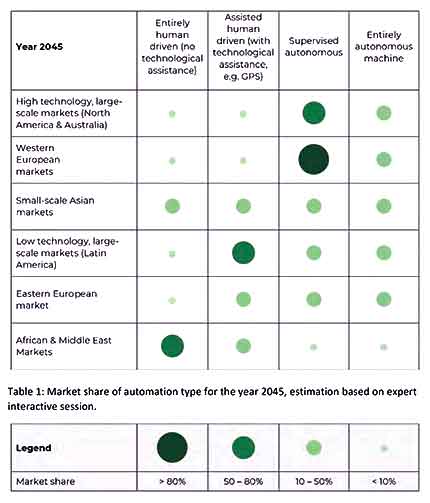|
|
|
You can get e-magazine links on WhatsApp. Click here
|
|
|
|
|
|
Driverless machines could impact agri, suggests study by Fraunhofer, KG
|
|
Tuesday, 12 November, 2019, 08 : 00 AM [IST]
|
|
Kaiserslautern
|
The development and introduction of machines ranging from highly automated to driverless will have a strong impact on global agriculture. These were among the findings conducted by the Fraunhofer Institute for Experimental Software Engineering IESE in cooperation with the Kleffmann Group (KG).
It dealt with the state-of-the-art as well as with the future worldwide development of the autonomous agricultural machinery market, and based on expert assessments and uses an empirical modelling approach to develop possible future scenarios up to the year 2045.
This inevitably raises the question of how fast and to what extent the new technologies will determine the market in the future.
Four basic autonomy levels of agricultural production were defined in order to predict their future development.
These are:
- Entirely human-driven machines (i.e., with no or low technological assistance)
- Assisted human-driven machines (i.e., with technological assistance, for instance, CPS-assisted driving)
- Supervised autonomous machines (i.e., using autonomous functions that are directly supervised by a human being)
- Entirely autonomous machines (i.e., without human supervision)
How will agricultural machinery develop in the future?
The key findings of the study were as follows:
Entirely human-driven systems will remain similar to the way they are today, but significant changes are expected for the other three classes.
Assisted systems will be able to support more complex actions. Being equipped with more cameras and more safety features.
The class of supervised autonomous machines will evolve in a long-term perspective to lower demands on supervisor presence and qualification over time and field- and application specific autonomous actions will evolve towards more universal actions.
The class of entirely autonomous machines will develop from pure demo systems via systems that act autonomously on the field with defined plans once they are there towards systems that receive rough planning via other systems and then act completely autonomously in the long run.
Regarding the development of the tractor market, it turns out that the demand for tractors will be mainly driven by Asian countries, whereas the uptake of autonomous technology will be led by North America and Western Europe (see Table 1).
What will the agricultural production cycle look like in the future?
The necessary process steps during a cultivation period are tillage, seeding/planting, weed control, fertilisation, plant protection and harvesting.
Autonomisation will have different effects on each level:
In the future, work steps with high tractive power, such as tillage or application of organic fertilisers, will be carried out autonomously by existing tractor systems. taking into account the lowest possible soil compaction.
A similar development is predicted for transport and logistics tasks, such as transport of harvested crops or manure.
The work steps seeding, mechanical weed control, mineral fertilisation and plant protection have high potential to be replaced in the future by autonomous machines or robot swarms. These work steps have the highest potential for increasing efficiency through site-specific applications.
Through continuous improvement of the autonomous process flows. The competing factor area performance will be balanced in the future. Especially in row crops (e.g., corn and sugar beets), autonomous approaches already exist with different robot sizes up to robot swarms.
In the harvesting step. novel approaches are conceivable. such as division into individual work steps. Initially, however. the focus will primarily be on automatic machine optimisation during operation.
Summary
In summary, the ag machinery industry will set its focus even more on single plants and the work steps around the plant will be increasingly automated due to the potential increase in efficiency achieved through reduced use of resources.
However, this shift towards autonomous agricultural systems is a rather slow process in the long run. In addition. The speed at which farmers will adopt autonomous systems will also differ substantially between different regions/markets. This is also a consequence of the different farm and production structures, of course.

|
|
|
|
|
|
|
|
|
|